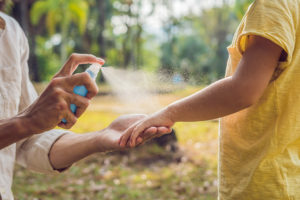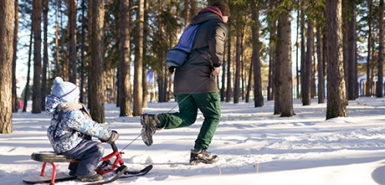
When summer hits, it’s time for kids to enjoy the outdoors.
Swimming in pools. Exploring the woods. Camping. Playing on the beach. Running at the playground.
And that’s exactly what they should be doing, although along with it comes the possibility of insect bites, scrapes and rashes, according to Angela Oostema, MD, a family medicine doctor with Spectrum Health Medical Group.
The most common summer skin problems? Sunburn, poison ivy rash, insect bites and infected wounds.
“It’s important for parents to know that there are many conditions that will resolve on their own,” Dr. Oostema said. “But they also should not downplay certain conditions, such as anything that is persistent or worsening, anything that is increasing in size or causing whole body symptoms. Then it’s important to call your doctor.”
Here are Dr. Oostema’s tips for preventing and treating uncomfortable skin problems.
Sunburn
Parents today have many tools to prevent sunburn in children, and Dr. Oostema recommends taking advantage of these. She reminds parents that the risk of skin cancer increases over time, with repeated sun exposure.
“It’s important to have a broad-spectrum sunscreen with an SPF of at least 30, but even more is better,” she said. “One thing that can help parents is to use long-sleeve rash guards and wide-brim hats for children, as they usually have a UPF protection of 50.
“The lighter the child’s complexion, the higher the risk of sunburn. And we get concerned about skin cancer down the road.”
SPF is the rating used for sunscreen and UPF is the rating used for clothing.
Broad-spectrum sunscreen protects against both UVA and UVB radiation. UVA rays penetrate deep into the skin and are linked with skin aging, while UVB rays are the ones that create sunburn.
Also important: Reapply sunscreen every two to three hours, and even more often if the child is sweating or swimming, Dr. Oostema said.
She admits it can be a challenge to convince teens to sun safely. One argument that might help: Tell teens that proper precautions can help prevent premature wrinkles.
“I don’t know anyone who wants those,” she said.
If your child gets sunburned, severe cases can cause blistering, she said. Care for these wounds by soothing them as much as possible with over-the-counter products that cool or numb the skin.
Some children are also susceptible to heat rash in the summer, Dr. Oostema said. Different from sunburn, this occurs when sweat glands get blocked and the moisture cannot escape. It looks like small pink or red bumps and is often found in covered places where the skin folds, such as elbows, armpits, knees or thighs.
Athletic-style, moisture-wicking fabrics actually can contribute to the problem because they hinder air flow. She recommends cotton clothing to keep children as cool as possible, then rinse off in the shower or bath after being in the heat.
Poison ivy, poison oak
Avoiding skin rashes from poison ivy or poison oak starts with teaching kids at a young age to identify the plants, Dr. Oostema said.
Other rules can help:
- Stay on marked trails.
- Wear long pants and long-sleeved shirts in the woods.
- Wash off when coming inside from places where you may have rubbed against plants.
Sometimes skin irritation occurs and it can be very uncomfortable for children. Parents can treat mild cases at home with calamine lotion or hydrocortisone cream.
If your child becomes extremely uncomfortable, however, or if the rash isn’t improving—or if you see signs of infection—it’s time to call your doctor, Dr. Oostema said.
Your child might need oral steroids or prescription topical ointments to treat the rash.
Infected wounds
“Our skin is a wonderful protective barrier for our bodies, but if we get scuffed knees or a cut, that allows the outside environment to come into contact with our bodies,” Dr. Oostema said.
Most kids heal fine when they have a cut or a scrape, but sometimes they can develop infection.
First, check to make sure there’s no foreign material in the wound. Then, wash and treat it with an anti-bacterial ointment. Bacitracin is Dr. Oostema’s favorite.
Finally, monitor the wound.
“Especially with heat and sweat, bacteria can multiply,” she said. “Look for signs of skin infection.”
This includes redness, warmth, tenderness and pus or drainage. She also recommends parents mark the perimeter of the red area with a pen to see if it’s getting worse or improving.
When in doubt, call the doctor.
Insect bites
Bees. Wasps. Mosquitoes. Ticks. Spiders.
Time outdoors means your child runs the risk of getting bitten or stung—and they may end up with a painful or itchy welt.
If your child is in pain at the time of the bite, it’s probably a stinging insect of some sort.
Dr. Oostema first recommends making sure there’s no stinger remaining in the skin. Then, apply a cool compress. Wash the area and apply calamine lotion or topical Benadryl.
Also watch for signs of a severe allergic reaction called anaphylaxis. Symptoms of anaphylaxis can include a rash or hives, airway swelling or difficulty breathing. Dr. Oostema said lesser-known symptoms include abdominal pain and nausea.
“Parents know their child and can tell when something is off,” she said. “If you suspect an anaphylactic reaction, you need to act quickly and get help immediately.”
If the reaction stays local around the bite, watch for the signs of infection.
“I don’t want parents to ever feel like they’re overreacting in any way with a large amount of redness or inflammation,” she said.
Tick bites present a whole other challenge—the threat of Lyme disease.
First, Dr. Oostema recommends parents research images of ticks and know the difference between deer ticks—which can spread Lyme disease—and dog ticks or other ticks.
Second, take preventive measures, such as having all your family members wear long-sleeved shirts and long pants in the woods. Third, check yourself, your children and your pets when coming inside.
If you find a tick attached to the skin, use a tweezer to remove it.
“Do not apply a lot of pressure,” she said. “You want to avoid squeezing the tick as much as possible.”
Lift up and remove the entire tick.
“If they have not been attached for more than 36 hours, there is less of a chance of Lyme disease,” she said.
Call your doctor if you think the tick has been attached more than a day or two, because the doctor may opt to prescribe antibiotics as a precaution. It must be done within 72 hours of tick removal, Dr. Oostema said.
If you notice the tell-tale target rash, call your doctor immediately, she said.
Before heading outside in the summer, make sure you’re armed with bug spray that contains DEET, Dr. Oostema said. Sprays that have DEET are safe for kids and they provide the broadest protection from ticks and insects.
Get your kids outside to enjoy the summer, but take smart precautions to protect their skin. And when in doubt, call your doctor, Dr. Oostema said.
“Parents should always remember they can always call us. We love our families and we are always here for them.”
 /a>
/a>
 /a>
/a>
 /a>
/a>